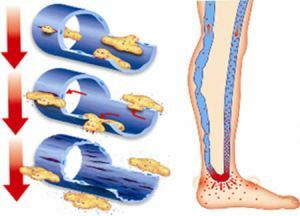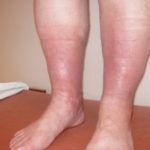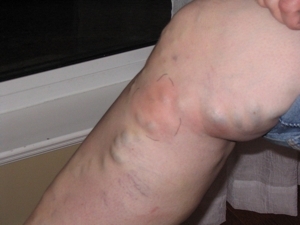 Phlebopathy is a disease that became widespread at the end of the last century.
Phlebopathy is a disease that became widespread at the end of the last century.
Phlebopathy is a whole complex of disorders of the venous system, which is closely associated with a decrease in the tone of the veins themselves.
Most often phlebopathy affects the veins of the lower extremities, it leads to deterioration of the human condition, pain and disruption of normal life. In its flow, phlebopathy is similar to a disease such as venous insufficiency.
Contents
- The main types of the disease
- What are the causes of the disease
- Symptoms and signs of phlebopathy
- Diagnostic methods
- How to cure the disease
- Complications and prediction
The main types of the disease
There are two types of phlebopathy:
- Orthostatic is a slowing down of the blood flow,for which the venous walls are stretched.
- Dyshormonal is associated with impaired metabolism and circulation.
The main types of phlebopathy include:
- Gormonozavimyu, which was the result of taking contraceptives on a hormonal basis.
- Orthostatic, which occurs due to stagnation of blood in the legs. Usually, this is a consequence of prolonged persistence of a standing or sitting position during the working day.
- Phlebopathy in pregnancy caused by fetal pressure on the veins, which significantly worsens the flow of blood.
- Hereditary, which is genetically inherent in the patient and his close relatives suffer from this disease.
A separate type of phlebopathy is retinal phlebopathy. What is this disease?
It is characterized by the widening of veins, the appearance of neoplasms of venules, the stagnation of blood in the vessels, the expansion of capillaries. But in the eyes these symptoms are not reflected.
The formed stagnation of blood disrupts the metabolism in the vitreous humor, which increases the varicose veins of the vessels of the fundus. Therefore, it is important not to allow the transition of phlebopathy to the next stage of development.
What are the causes of
? Venous congestion contributes to the appearance of phlebopathy symptoms, and the following causes it:
- prolonged exposure to venous blood outflow( increase in blood outflow or its decrease), that is, the risk of developing phlebopathyis directly connected with a long sedentary work of a person or if a person spends the whole working day "on his feet";
- failure in the human hormonal system, this is most often related to pregnant women or women during menopause;
- is a hereditary predisposition to the disease. According to studies, phlebopathy is observed in 50% of patients who are at risk associated with heredity.
Thus, factors contributing to the development of phlebopathy, include in itself:
- professional activity;

- is a sedentary lifestyle;
- squeezing the veins of the legs during pregnancy;
- impaired blood flow due to pelvic tumor;
- hormonal changes in the background;
- excessive physical exertion.
These reasons can be combined with each other, so you can not say that the presence of the disease in the patient is due to one of these reasons. Usually, phlebopathy develops as a result of the interaction of several causes.
Symptoms and signs of phlebopathy
Symptoms of phlebopathy - are:
- decrease in the elasticity of the veins, as well as the ability to reduce the musculature of the venous walls;
- significant inflow or difficult outflow of blood from blood vessels;
- reduced the tone of the veins, which causes an increase in blood flow in women during pregnancy.
Symptoms of the disease manifest themselves in the subjective sensations of the patient, while there are no external changes or pathologies.
No functional disturbances are observed either.
Symptoms of include:
- swelling of the legs at the end of the working day;
- rapid fatigue with long-term retention;
- nocturnal cramps;
- heaviness in the legs.
 Women are most often affected by this disease. Symptoms move on increasing, appearing more and more actively.
Women are most often affected by this disease. Symptoms move on increasing, appearing more and more actively.
If you notice at least one symptom of this disease, you should not delay and start the disease in order to avoid complications. Everyone knows that diseases in the early stages are much more amenable to treatment than the neglected state of the patient.
Therefore, strongly recommends that you contact an specialist and do not self-medicate, which can lead to unpleasant consequences.
Diagnostic methods
The main method for the diagnosis of blood vessel disorders is duplex angioscanning. But with phlebopathy, its use is not effective and does not allow the diagnosis to be accurately determined.
The decrease in the tone of the veins, as the main symptom of phlebopathy, is established by the method of plethysmography, which is based on the study of pulse fluctuations in blood volume and the study of changes in the volume of the tibia throughout the day.
It is quite difficult to diagnose phlebopathy, so be careful about choosing a medical institution.
As the symptoms of phlebopathy and other vein diseases are very similar to each other, the diagnosis is of decisive importance for subsequent treatment. Only an experienced, qualified specialist will conduct the necessary examinations, which will help to eliminate other diseases of the venous system.
 What signs of thrombosis should be known in order to diagnose and start treatment of the disease in time. How safe and effective is treatment of varicose with salt? Recipes, tips and techniques highlights our material.
What signs of thrombosis should be known in order to diagnose and start treatment of the disease in time. How safe and effective is treatment of varicose with salt? Recipes, tips and techniques highlights our material. How to cure the disease
Treatment of phlebopathy is caused by elastic compression and drug treatment .
So, for the treatment of is used:
- Elastic compression involves wearing medical knitwear of the first degree of compression when a symptomatic complex of phlebopathy appears or during prophylaxis during pregnancy.
- Medication treatment of is phlebotonics, venotonizing drugs, ointments, gels that help to remove swelling of the legs, relieve pain, improve microcirculation of lymph and blood.
- As for surgical intervention , it is not performed, because due to the decrease in the tone of the walls of the veins, the muscle layer is thinned, and it is impossible to remove all the formed stars, surgical sockets and other neoplasms of the capillary system surgically. Therefore, there is no indication for surgical treatment.
- Also for treatment use gymnastics , given possible recommendations for changing the lifestyle and mobility of a person.
Complications and Forecast
When performing the doctor's recommendations, conducting an active lifestyle, reducing the risk of illness due to professional activity, taking  prescribed medications and medical compression can completely cure a disease such as phlebopathy.
prescribed medications and medical compression can completely cure a disease such as phlebopathy.
Compliance with the regime of work and rest, proper nutrition contribute to the elimination of the disease.
If you do not take seriously the treatment of phlebopathy, the complication may be thrombophlebitis, trophic disorders and other diseases of the veins.
Thus, phlebopathy is a disease that is characterized by a violation of the normal operation of the veins, most often of the lower limbs. Symptoms of the disease are subjective, so it is important to consult a doctor in time and follow his instructions. In this case, you can forget about phlebopathy. Be attentive to your health!
